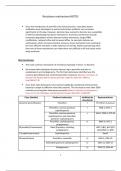Resistance mechanisms NOTES
⦁ Since the introduction of penicillin into clinical practice, many beta lactam
antibiotics were developed, as well as beta lactam antibiotic use increased
significantly to this day. However, bacteria have evolved to become less susceptible
to them by developing resistance mechanisms. 4 primary mechanisms include
enzymatic degradation of beta lactams by beta lactamases, target (PBP)
modification, reduced influx and increased efflux. As new beta lactams are
synthesised, which increases selective pressure, these mechanisms are evolving to
be more efficient and have a wider spectrum of activity. Bacteria possessing more
than one of these mechanisms can make them very difficult to kill and cause multi-
drug resistance
Beta Lactamases
⦁ The most common mechanism of resistance especially in Gram -ve bacteria
⦁ An enzyme that hydrolyses the beta lactam ring in penicillin and later in
cephalosporin and carbapenems. The first beta lactamase identified was the
S.aureus penicillinase that conferred penicillin resistance (Abraham and Chain, An
enzyme from bacteria able to destroy penicillin. 1940, Rev Infect Dis. 1988 Jul-
Aug;10(4):677-8)
⦁ Since then, beta lactamases have evolved rapidly (by mutations) which permits
bacteria to adapt to different novel beta lactams. This has lead to more than 2000
naturally occurring beta lactamases presently (Robert A. Bonomo, β-Lactamases: A
Focus on Current Challenges, Cold Spring Harb Perspect Med 2017;7:a025239)
Class (Ambler) Preferred substrates Inhibited by Representatives
clavulanate
A (serine penicillinases) Penicillins + PC1 (from S.aureus)
Penicillins, narrow-spectrum + TEM-1; SHV-1
cephalosporins
Penicillins, narrow-spectrum + SHV2; TEM-3; CTX-M
cephalosporins and extended-
spectrum cephalosporins
Penicillins, cephalosporins, +/- NMC-A; KPC-2
carbapenems
B (metallo-β-lactamases) Most β-lactams, including - IMP-1 (B1); BcII (B1)
carbapenems CphA (B2); L1 (B3)
C (cephalosporinases) Cephalosporins - AmpC
D (oxacillinases) Penicillins, cloxacillin +/- OXA-1; OXA-10
Extended-spectrum cephalosporins +/- OXA-11; OXA-15
Carbapenems +/- OXA-23; OXA-48
1
,Adapted from Bush and Jacoby, 2010 (Karen Bush, George A. Jacoby, Updated Functional
Classification of β-Lactamases, Antimicrob Agents Chemother. 2010 Mar; 54(3): 969–976.)
⦁ 4 classes of beta lactamases: A, B, C, and D that hydrolyse penicillins,
cephalosporins, carbapenems and cephamycins (structure shown in figure). Have a
summarised table from the previous reference. These four classes are grouped into
serine beta lactamases (A, C, D) and metallo-beta-lactamases (B) where the serine
beta lactamases show structural similarities- 2 domains: α/β and α. TEM-1 have 5
stranded beta sheet and 3 alpha helices in α/β; 8 alpha helices in α
Class A TEM1 beta lactamase (PDB: 1XPB)
2
, Class D OXA1 beta lactamase (PDB: 3ISG)
3




